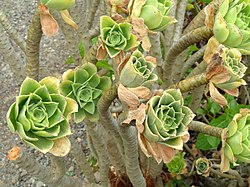| Aeonium balsamiferum | |
|---|---|
 | |
| Aeonium balsamiferum at the University of California Botanical Garden | |
| Scientific classification | |
| Kingdom: | Plantae |
| Clade: | Tracheophytes |
| Clade: | Angiosperms |
| Clade: | Eudicots |
| Order: | Saxifragales |
| Family: | Crassulaceae |
| Genus: | Aeonium |
| Species: | A. balsamiferum |
| Binomial name | |
| Aeonium balsamiferum | |
| Synonyms [2] | |
| |
Aeonium balsamiferum (Spanish : bejeque farrobo) is a species of tropical flowering plant in the family Crassulaceae . The species is endemic in the Canary Islands.


